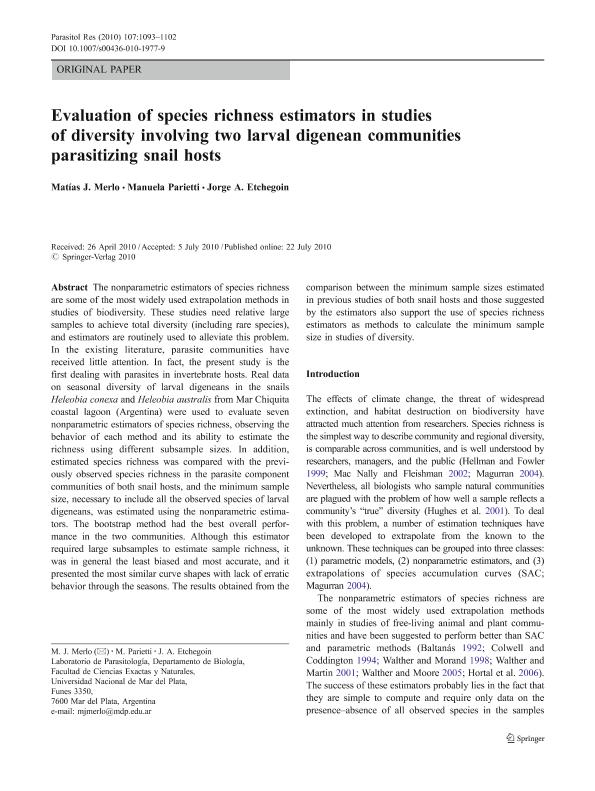Mostrar el registro sencillo del ítem
dc.contributor.author
Merlo, Matias Javier

dc.contributor.author
Parietti, Manuela

dc.contributor.author
Etchegoin, Jorge Alejandro

dc.date.available
2020-01-29T14:30:27Z
dc.date.issued
2010-07
dc.identifier.citation
Merlo, Matias Javier; Parietti, Manuela; Etchegoin, Jorge Alejandro; Evaluation of species richness estimators in studies of diversity involving two larval digenean communities parasitizing snail hosts; Springer; Parasitology Research; 107; 5; 7-2010; 1093-1102
dc.identifier.issn
0932-0113
dc.identifier.uri
http://hdl.handle.net/11336/96090
dc.description.abstract
The nonparametric estimators of species richness are some of the most widely used extrapolation methods in studies of biodiversity. These studies need relative large samples to achieve total diversity (including rare species), and estimators are routinely used to alleviate this problem. In the existing literature, parasite communities have received little attention. In fact, the present study is the first dealing with parasites in invertebrate hosts. Real data on seasonal diversity of larval digeneans in the snails Heleobia conexa and Heleobia australis from Mar Chiquita coastal lagoon (Argentina) were used to evaluate seven nonparametric estimators of species richness, observing the behavior of each method and its ability to estimate the richness using different subsample sizes. In addition, estimated species richness was compared with the previously observed species richness in the parasite component communities of both snail hosts, and the minimum sample size, necessary to include all the observed species of larval digeneans, was estimated using the nonparametric estimators. The bootstrap method had the best overall performance in the two communities. Although this estimator required large subsamples to estimate sample richness, it was in general the least biased and most accurate, and it presented the most similar curve shapes with lack of erratic behavior through the seasons. The results obtained from the comparison between the minimum sample sizes estimated in previous studies of both snail hosts and those suggested by the estimators also support the use of species richness estimators as methods to calculate the minimum sample size in studies of diversity.
dc.format
application/pdf
dc.language.iso
eng
dc.publisher
Springer

dc.rights
info:eu-repo/semantics/openAccess
dc.rights.uri
https://creativecommons.org/licenses/by-nc-sa/2.5/ar/
dc.subject
SNAIL
dc.subject
LARVAL DIGENEANS
dc.subject
RICHNESS
dc.subject
SAMPLE SIZE
dc.subject.classification
Ecología

dc.subject.classification
Ciencias Biológicas

dc.subject.classification
CIENCIAS NATURALES Y EXACTAS

dc.title
Evaluation of species richness estimators in studies of diversity involving two larval digenean communities parasitizing snail hosts
dc.type
info:eu-repo/semantics/article
dc.type
info:ar-repo/semantics/artículo
dc.type
info:eu-repo/semantics/publishedVersion
dc.date.updated
2020-01-28T15:00:17Z
dc.journal.volume
107
dc.journal.number
5
dc.journal.pagination
1093-1102
dc.journal.pais
Alemania

dc.description.fil
Fil: Merlo, Matias Javier. Universidad Nacional de Mar del Plata. Facultad de Ciencias Exactas y Naturales. Departamento de Biología. Laboratorio de Parasitología; Argentina. Consejo Nacional de Investigaciones Científicas y Técnicas; Argentina
dc.description.fil
Fil: Parietti, Manuela. Universidad Nacional de Mar del Plata. Facultad de Ciencias Exactas y Naturales. Departamento de Biología. Laboratorio de Parasitología; Argentina. Consejo Nacional de Investigaciones Científicas y Técnicas; Argentina
dc.description.fil
Fil: Etchegoin, Jorge Alejandro. Universidad Nacional de Mar del Plata. Facultad de Ciencias Exactas y Naturales. Departamento de Biología. Laboratorio de Parasitología; Argentina. Consejo Nacional de Investigaciones Científicas y Técnicas; Argentina
dc.journal.title
Parasitology Research

dc.relation.alternativeid
info:eu-repo/semantics/altIdentifier/doi/http://dx.doi.org/10.1007/s00436-010-1977-9
dc.relation.alternativeid
info:eu-repo/semantics/altIdentifier/url/https://link.springer.com/article/10.1007/s00436-010-1977-9
Archivos asociados
